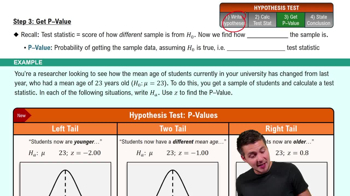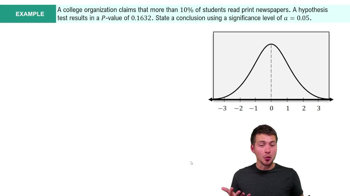A survey claimed that of adults prefer electric cars over traditional cars. A car manufacturer believes the true proportion is higher than . To test this, they survey a random sample of adults and find that say they prefer electric cars. Determine which test statistic to use & calculate it.
Table of contents
- 1. Intro to Stats and Collecting Data1h 14m
- 2. Describing Data with Tables and Graphs1h 55m
- 3. Describing Data Numerically2h 5m
- 4. Probability2h 16m
- 5. Binomial Distribution & Discrete Random Variables3h 6m
- 6. Normal Distribution and Continuous Random Variables2h 11m
- 7. Sampling Distributions & Confidence Intervals: Mean3h 23m
- Sampling Distribution of the Sample Mean and Central Limit Theorem19m
- Distribution of Sample Mean - Excel23m
- Introduction to Confidence Intervals15m
- Confidence Intervals for Population Mean1h 18m
- Determining the Minimum Sample Size Required12m
- Finding Probabilities and T Critical Values - Excel28m
- Confidence Intervals for Population Means - Excel25m
- 8. Sampling Distributions & Confidence Intervals: Proportion1h 12m
- 9. Hypothesis Testing for One Sample3h 29m
- 10. Hypothesis Testing for Two Samples4h 50m
- Two Proportions1h 13m
- Two Proportions Hypothesis Test - Excel28m
- Two Means - Unknown, Unequal Variance1h 3m
- Two Means - Unknown Variances Hypothesis Test - Excel12m
- Two Means - Unknown, Equal Variance15m
- Two Means - Unknown, Equal Variances Hypothesis Test - Excel9m
- Two Means - Known Variance12m
- Two Means - Sigma Known Hypothesis Test - Excel21m
- Two Means - Matched Pairs (Dependent Samples)42m
- Matched Pairs Hypothesis Test - Excel12m
- 11. Correlation1h 6m
- 12. Regression1h 50m
- 13. Chi-Square Tests & Goodness of Fit1h 57m
- 14. ANOVA1h 57m
9. Hypothesis Testing for One Sample
Steps in Hypothesis Testing
Problem 8.1.22
Textbook Question
Final Conclusions
In Exercises 21–24, use a significance level of α = 0.05 and use the given information for the following:
State a conclusion about the null hypothesis. (Reject H0 or fail to reject H0.)
Without using technical terms or symbols, state a final conclusion that addresses the original claim
Original claim: More than 35% of air travelers would choose another airline to have access to inflight Wi-Fi. The hypothesis test results in a P-value of 0.00001.
 Verified step by step guidance
Verified step by step guidance1
Step 1: Identify the null hypothesis (H0) and the alternative hypothesis (H1). The null hypothesis (H0) is that 35% or fewer air travelers would choose another airline to have access to inflight Wi-Fi (p ≤ 0.35). The alternative hypothesis (H1) is that more than 35% of air travelers would choose another airline to have access to inflight Wi-Fi (p > 0.35).
Step 2: Compare the P-value to the significance level (α = 0.05). The P-value provided is 0.00001, which is much smaller than the significance level of 0.05.
Step 3: Based on the comparison, decide whether to reject or fail to reject the null hypothesis. Since the P-value is less than α, we reject the null hypothesis (H0).
Step 4: Translate the statistical conclusion into plain language. Rejecting the null hypothesis means there is sufficient evidence to support the claim that more than 35% of air travelers would choose another airline to have access to inflight Wi-Fi.
Step 5: Final conclusion: Based on the data and the hypothesis test, it can be concluded that more than 35% of air travelers would choose another airline to have access to inflight Wi-Fi.
 Verified video answer for a similar problem:
Verified video answer for a similar problem:This video solution was recommended by our tutors as helpful for the problem above
Video duration:
5mPlay a video:
Was this helpful?
Key Concepts
Here are the essential concepts you must grasp in order to answer the question correctly.
Null Hypothesis (H0)
The null hypothesis is a statement that assumes no effect or no difference in a given situation. In this context, it posits that 35% or fewer air travelers would choose another airline for inflight Wi-Fi. Understanding the null hypothesis is crucial for determining whether the evidence supports or contradicts this claim.
Recommended video:
Guided course

Step 1: Write Hypotheses
P-value
The P-value is a statistical measure that helps determine the strength of the evidence against the null hypothesis. A low P-value, such as 0.00001 in this case, indicates strong evidence that the null hypothesis may be rejected. This means that the observed data is highly unlikely under the assumption that the null hypothesis is true.
Recommended video:
Guided course

Step 3: Get P-Value
Significance Level (α)
The significance level, denoted as α, is the threshold for deciding whether to reject the null hypothesis. In this scenario, α is set at 0.05, meaning that if the P-value is less than 0.05, we reject the null hypothesis. This concept is essential for interpreting the results of hypothesis testing and making informed conclusions.
Recommended video:
Guided course

Step 4: State Conclusion Example 4

 6:21m
6:21mWatch next
Master Step 1: Write Hypotheses with a bite sized video explanation from Patrick
Start learningRelated Videos
Related Practice
Multiple Choice
